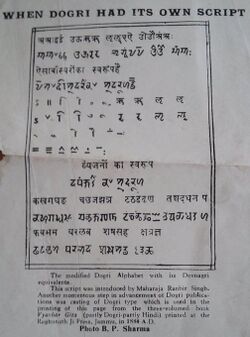Dogri script
| Dogri script 𑠖𑠵𑠌𑠤𑠬 | |
|---|---|
| Type | Abugida
|
| Languages | Dogri |
Parent systems | Proto-Sinaitic alphabet [a]
|
Sister systems | Gurmukhī |
| Direction | Left-to-right |
| ISO 15924 | Dogr, 328 |
Unicode alias | Dogra |
| U+11800–U+1184F | |
The Dogri script (also known as Dogra Akkhar script) is a writing system originally used for writing the Dogri language in Jammu and Kashmir in the northern part of the Indian subcontinent.[3] The Takri script version of Jammu is known as Dogra Akkhar[4]
Efforts of revival
Dogri was included on the signboards at Jammu Tawi railway station. This triggered enthusiasm among particularly the youngsters who were in large numbers sharing it on the social media.
Although the language has been given recognition at the central level, but there were allegations of the Jammu and Kashmir government giving it “step-motherly” treatment. Adequate steps were not being taken to teach the language at the school and college levels.[5]
Unicode
The Dogri script was added as a Unicode block to the Unicode Standard in June, 2018 with the release of version 11.0.[6]
The Unicode block is named Dogra, at U+11800–U+1184F, and contains 60 characters:
History
The following Unicode-related documents record the purpose and process of defining specific characters in the Dogra block:
| Version | Final code points[lower-alpha 1] | Count | L2 ID | WG2 ID | Document |
|---|---|---|---|---|---|
| 11.0 | U+11800..1183B | 60 | L2/15-213 | Pandey, Anshuman (2015-07-30), Preliminary proposal to encode the Dogra script | |
| L2/15-312 | Anderson, Deborah; Whistler, Ken; McGowan, Rick; Pournader, Roozbeh; Glass, Andrew; Iancu, Laurențiu (2015-11-01), Recommendations to UTC #145 November 2015 on Script Proposals | ||||
| L2/15-234R | Pandey, Anshuman (2015-11-04), Proposal to encode the Dogra script | ||||
| L2/15-254 | Moore, Lisa (2015-11-16), UTC #145 Minutes | ||||
| L2/17-201 | N4862 | A, Srinidhi; A, Sridatta (2017-06-25), Proposal to encode the DOGRA VOWEL SIGN VOCALIC RR | |||
| L2/17-255 | Anderson, Deborah; Whistler, Ken; Pournader, Roozbeh; Moore, Lisa; Liang, Hai (2017-07-28), Recommendations to UTC #152 July-August 2017 on Script Proposals | ||||
| L2/17-222 | Moore, Lisa (2017-08-11), UTC #152 Minutes | ||||
| N4953 (pdf, doc) | Unconfirmed minutes of WG 2 meeting 66, 2018-03-23 | ||||
| L2/17-353 | Anderson, Deborah; Whistler, Ken (2017-10-02), WG2 Consent Docket | ||||
| L2/17-362 | Moore, Lisa (2018-02-02), UTC #153 Minutes | ||||
| |||||
References
- ↑ "Unicode character database". The Unicode Standard. https://www.unicode.org.
- ↑ "Enumerated Versions of The Unicode Standard". The Unicode Standard. https://www.unicode.org/versions/enumeratedversions.html.
- ↑ Pandey, Anshuman (2015-11-04). "L2/15-234R: Proposal to encode the Dogra script". https://www.unicode.org/L2/L2015/15234r-dogra.pdf.
- ↑ Ireland, Royal Asiatic Society of Great Britain and (1834) (in en). Journal of the Royal Asiatic Society of Great Britain & Ireland. Cambridge University Press for the Royal Asiatic Society. https://books.google.com/books?id=TPgAAAAAYAAJ&q=Jammu+Takri&pg=PA67.
- ↑ "Dogri script finds place on signposts at Jammu railway station" (in en-US). 2018-05-04. https://www.thestatesman.com/cities/dogri-script-finds-place-on-signposts-at-jammu-railway-station-1502631179.html.
- ↑ "Unicode 11.0.0". Unicode Consortium. June 5, 2018. https://www.unicode.org/versions/Unicode11.0.0/.
External links




